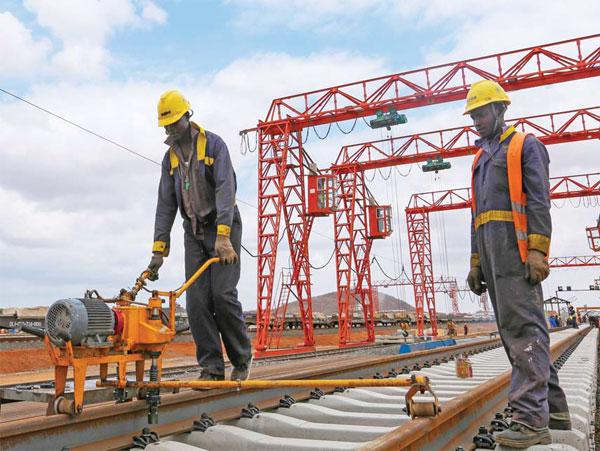In Kenya, railway construction faces challenges
Updated: 2016-11-11 07:35
By Edith Mutethya(China Daily Europe)
|
|||||||||
Work is set to start early next year on the challenging second phase of Kenya's standard gauge railway network development.
The northern corridor link, known as 2A, will be constructed by China Road and Bridges Corp, following commissioning of the project by the Kenyan President Uhuru Kenyatta on Oct 19.
The Ksh 150 billion ($1.5 billion; 1.35 billion euros; 1.2 billion) project will extend from Nairobi to Naivasha, the country's geothermal production center, located in the northwest of the city.
While this phase of the project is only 120 kilometers long, it is expected to take longer to construct owing to the mountainous terrain.
|
Workers at the construction site of the Mombasa-Nairobi standard gauge railway in Kenya. Pan Siwei / Xinhua |
It is estimated it will take four-and-half years to complete, compared with the first phase - the 472 km Nairobi-Mombasa Standard Gauge Railway - which is expected to take just two years.
The Nairobi-Mombasa project should be completed in December, six months ahead of schedule. Trial operations are scheduled to begin in January, with the railway opening officially the following June.
According to CRBC, the geographical conditions of Ngong Hills and Great Rift Valley are unfavorable and the terrain is complex.
"To overcome the adverse conditions for phase 2A, we plan a large amount of high backfilling and deep cutting. For specific sections, we will construct slab-pile walls or retaining walls to prevent slopes from collapsing," a report from CRBC states.
The project will also involve the construction of four tunnels, the longest of which will be more than 4.5 km and the shortest half a kilometer. Nine long bridges will also be built, three of them more than a kilometer in length, with the longest being 6.7 km, traversing Nairobi National Park. It will be the third-longest bridge in Africa after October Bridge in Cairo, Egypt, which is 20.5 km long, and Third Mainland Bridge, in Lagos, Nigeria, at 10.5 km.
Commissioning the project in October, President Kenyatta urged communities along the route to cooperate with the contractor to ensure the project is completed on schedule.
Clearing the air over fears about land compensation - previously a source of major conflict between the contractor and local communities - Kenyatta assured residents that once the land is surveyed the National Land Commission will evaluate it and the affected people will be compensated. The compensation funds, he said, had already been set aside in the Railway Development Fund.
The president hit out at local leaders, including members of county assemblies, for allegedly inciting residents to attack SGR workers.
On Aug 28, a group of Masai youths attacked 14 Chinese nationals at the Duka Moja Railway construction site in Narok county, demanding job opportunities from the contractor.
Kenyatta advised residents to voice their grievances through official channels such as county governments, the Ministry of Transport and regional commissioners.
"If you attack the workers, it means the project will be suspended, hence you lose your jobs. Please don't opt to do that," he said.
Atanas Maina, managing director of Kenya Railways, says the government has beefed up security to ensure that employees are not attacked.
Maina says the government is engaging various stakeholders to impress on local communities the benefits of the SGR, from job opportunities to lowering the cost of production, making Kenya a more attractive investment destination.
"We will be holding meetings with leaders from various counties alongside the railway line, after which they will engage their electorates to ensure they support the project," he says.
The Nairobi-Naivasha SGR project is expected to create more than 20,000 jobs and will traverse five counties: Nairobi, Kajiado, Kiambu, Nakuru and Narok.
The contractor has promised to source 40 percent of suppliers locally, as required by law.
edithmutethya@chinadaily.com.cn
(China Daily European Weekly 11/11/2016 page7)
Today's Top News
China, UK 'golden era' strengthens
UK business calls for a London-only visa system
First Chinese named as new Interpol chief
Chinese-Hungarian Friendship awards presented
Polls missed support for Trump
Superstars party with Jack Ma before shopping spree
Europe would elect Clinton: Poll
Obama, Trump meet at White House
Hot Topics
Lunar probe , China growth forecasts, Emission rules get tougher, China seen through 'colored lens', International board,
Editor's Picks

|

|

|

|

|

|








